Pollen and winter bees
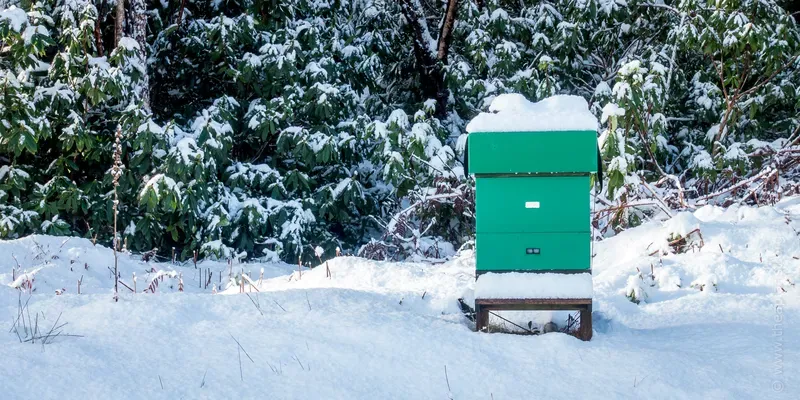
Across the country, beekeepers are experiencing the first unpleasant withdrawal symptoms of going 'cold turkey' ... the start of the not beekeeping season. After the hustle and bustle of the late summer honey harvest, followed by feeding and treating, there's suddenly nothing to do.
Well, perhaps not nothing, but certainly very little compared to the height of the season which was just a few short weeks ago.
Suddenly weekends appear a lot longer, there is no need for an additional hurried frame building session midweek, and the excuse of 'just nipping to the apiary to check on things' (and so avoid the washing up) no longer works {{1}}.
If the weather remains favourable the garden can finally get some desperately-needed attention. Not cutting the grass does not automagically create a wildflower meadow, or anything close. It just leaves a tussocky swathe of coarse grass on which the lawnmower chokes to a standstill {{2}}.
And, if the weather is unfavourable, then there are probably some decorating or DIY chores jobs that you have studiously avoided since last March.
Or, the March before that.
This painful withdrawal period only lasts a month or so. The weather often remains good enough that the bees are flying well, so it feels a bit weird not inspecting colonies or doing one of the myriad of other jobs that keep us busy all summer.
It feels odd not to have to check things in the hives, or add things to the hives, or remove things from the hives.
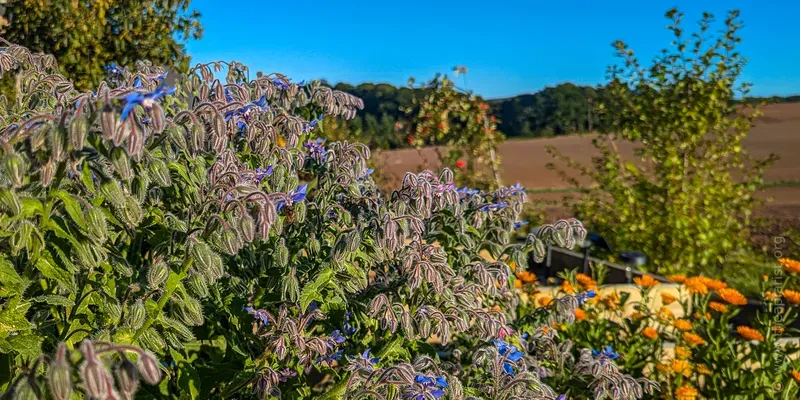
Late flowering borage and lavender in my garden is getting lots of attention from honey and bumble bees, both trying to make the most of the limited nectar and pollen sources that are still remaining.
And, once they're gone (the bees, the nectar and the pollen), the arrival of shorter days and long, dark evenings, mean that the season is well and truly over.
But there's always next year to think about.
The beekeeping writer
For a beekeeping writer this limbo period - between the labours of summer and the winter preparations for the season ahead - is a tricky one.
There's essentially no beekeeping to write about, and it's probably too soon to meaningfully discuss planning and preparation for next season.
Posts (and talks) that are best liked - for example, quantified in terms of comments or questions - are those that are timely.
That's why I don't write about the mechanics of queen rearing in November. It's not relevant to the vast majority of my readership, most of whom are from the Northern Hemisphere.
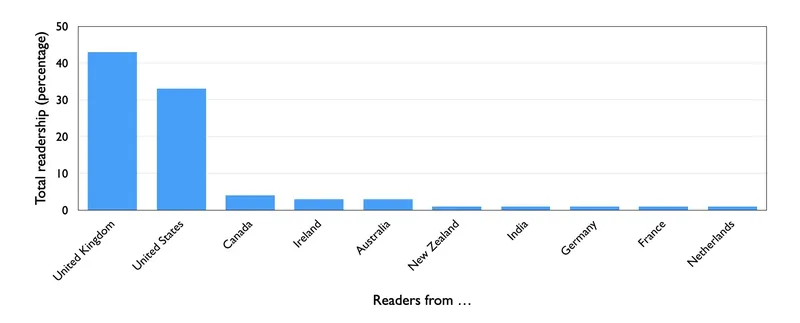
Although I know there are a lot of regular readers in Australia and New Zealand, it's simply not practical to cater for ~4% of the total readership with timely posts about Spring expansion, queen rearing or swarm control as the days here are shortening and thoughts are turning to skiing, or Christmas ... or more elaborate excuses to avoid the decorating and gardening.
So, what do I write about?
Do I recount a series of faintly amusing or vaguely informative anecdotes about what went right - or more probably wrong - with the season just gone? {{3}}
Despite doing a reasonable amount of beekeeping during the year, those 'informative or amusing' anecdotes are limited and valuable. They need to be rationed out a bit ... there's a long winter ahead, and I don't want to use them all at once.
Blind 'em with science
Instead, perhaps I should write about some of the great science that's been done with honey bees this year?
And not just this year. There's an almost limitless supply of material stretching back decades, much of which is little known, some of which is very relevant to our bees (and even our beekeeping), and almost all of which is never mentioned in the howto-type information Googled by beekeepers searching for an explanation of how to do a Pagden or Taranov and which is the 'better' method of swarm control.
In this instance, as is often the case, the 'why?' is more interesting than the 'how?'.
But as a lifetime in academic research has demonstrated "All science and no play makes Jack a dull boy", or something like that.
I'm aware that some readers don't appreciate the science. They stop reading at the first graph (in which case, I've lost them already), their eyes glaze over when terms like 'temporal polyethism' appear {{4}}, or they simply do not care about whether things are significant or not.
Many readers just want to know the recipe for thin syrup, or whether they can use oxalic acid when there are supers on the hive (and neither of these topics are particularly interesting).
Ho hum.
This post was originally going to be about undertaker bees, necrophoresis, hygienic behaviour and the pong of a corpse. These are all fascinating (and related) subjects, but perhaps too science-y after the discussion of dancing bees last week.
Perhaps another time?
Instead, I'm going to intermingle some discussion of the last colonies I looked at and the timing of winter bee production.
Which will inevitably involve a bit of science 😉.
Some, not no, beekeeping
My honey supers were removed on the 20th of August. On the same afternoon I added a single 12.5 kg block of fondant and two Apivar strips to each hive.
The colonies were still bulging with bees, and this was particularly obvious as I'd cleared 3-4 supers down into a single brood box. They were overflowing the edges at the top of the box, and considerable care was needed adding the framed, wired queen excluder (QE) to support the fondant. I provided header space for the fondant, either using an inverted polycarbonate crownboard or an empty super. This gives the bees a bit of 'elbow room' and probably prevents them bearding out of the entrance on warmer days.
Almost all the colonies still had lots of brood; except for one queenless colony (shaken out) most had 7-9 frames of brood in all stages.
These weren't proper hive inspections. Instead, they were cursory checks to find the 'edges' of the brood nest so I knew where to position the Apivar strips.
That done, I bid adieu to the bees, and tottered off to extract the honey.
One month later ...
I combined a circuitous honey delivery trip with a visit to the apiaries to reposition the Apivar strips around the rapidly shrinking brood nest. It was a lovely day with warm sunshine and fluffy white clouds, though by late afternoon - when I got to the hives - it was cooling rapidly, emphasising the fast-approaching autumn.
Why 'shrinking'?
The egg-laying rate of the queen slows from midsummer until mid/late autumn. Depending upon the latitude, the age of the queen, the weather and the forage available, some queens slow down and 'shut up shop' earlier than others.
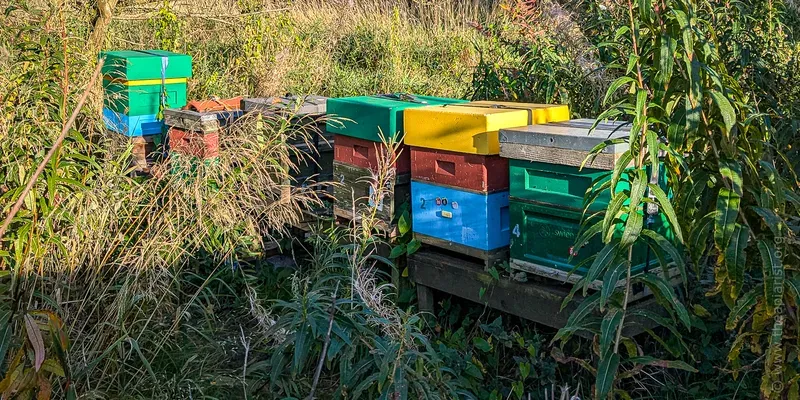
Some never stop laying, with the colony rearing reduced amounts of brood all winter.
However, in my part of Scotland {{5}} egg laying slows in July, is at pretty low levels by late-September and has usually stopped completely a month later.
And this was obvious when I quickly searched through the boxes for the periphery of the brood nest.
Fewer bees and less brood
The first thing to notice was that the numbers of bees were much reduced. The boxes were still well-populated, but a puff or two of smoke across the top of the brood box pushed almost all of them down {{6}}, rather than creating wriggling 'gloops' of bees cascading over the outer edges of the box.
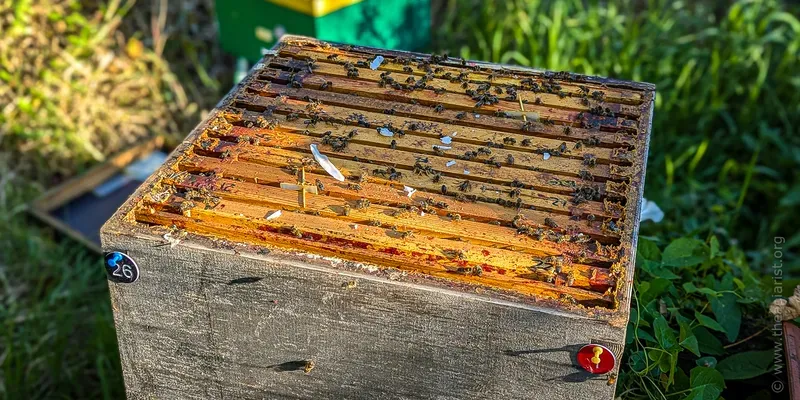
I removed the dummy board and the outer frame (now packed tight with capped stores) and split the frames at one of the Apivar strips to make some space. I then moved towards the middle of the box, jumping two frames at a time, simply looking for the edge of the brood nest.
In most hives the brood nest was no more than one or two frames, several had no obvious sealed brood and none had more than 3 frames.
I included the qualifying 'obvious' as this was not a rigorous inspection. I didn't bother looking for eggs {{7}} and didn't shake bees from the frames. Even in colonies lacking sealed brood, the central frame or two contained an arc of stores over 'empty' comb, and it's quite possible that the queen was still laying small amounts of eggs in this space.
The reduced population of adult bees reflects the massive changes in the colony as it prepares for winter. Essentially the entire population of bees is replaced, with the short-lived summer bees being replaced with long-lived winter bees.
But this transition is not 'like for like'. The total number of bees in the population is also decreasing. The summer bee population might reach 30,000+, but the winter bee population is significantly smaller, even at the start of the winter.
Now you see it, now you don't
I'll segue from beekeeping practice to honey bee theory in a few paragraphs, but should first comment on the fondant block added to the colony in August.
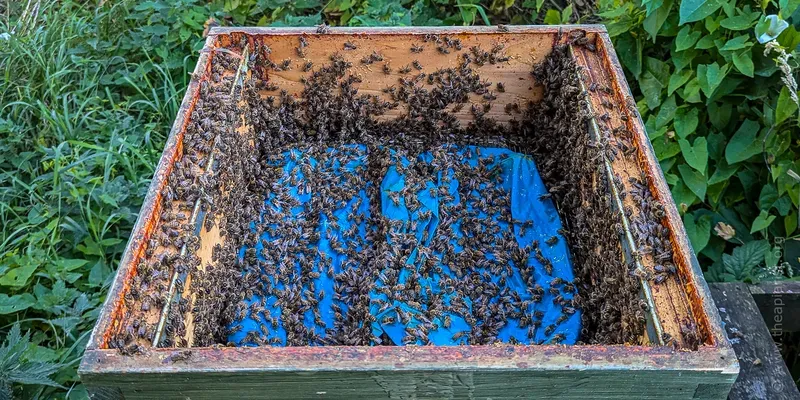
The majority of hives had emptied the 12.5 kg block of fondant, leaving just the propolised blue plastic 'husk' over the QE.
This fondant has been stored, not consumed. The brood box was reassuringly heavy, and any frames not occupied by brood were packed solid with capped stores.
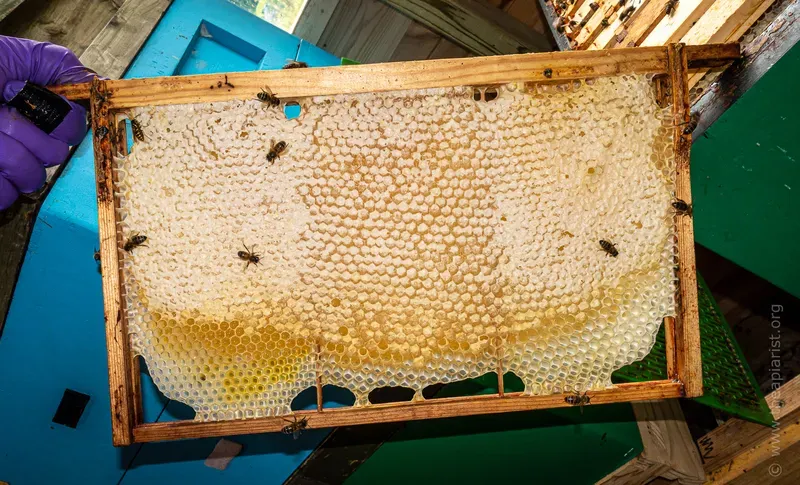
Removing this 'husk' is easy. Grab the central 'hinge' region (between the two - now empty - halves of the block) with your finger and thumb and pull upwards. The upper and lower side of the bag will probably be covered in bees, but doing it like this allows you to then shake them off into the 'funnel' created by the surrounding empty super.
The bag will almost certainly be stuck down to the QE, but this blue plastic is too thick for the bees to chew or drag down into the brood nest.
Just keep on gently tugging and it will eventually pull free.
As an aside, don't ever use Clingfilm to cover the face of the fondant - either when using entire blocks, or pitiful little 200 g lumps of the stuff to 'top up' the colony if it feels too light. The bees chew the Clingfilm, drag it down into the nest and make a right mess.
If the hive does feel too light, give them at least 1-2 kg. You cannot tell when a colony is underweight by a few hundred grams, it saves repeated visits and the bees will use it for Spring expansion. Here endeth the lesson ...
With the bag removed, the super is prised off, the bees shaken back onto the top of the QE which is gently smoked and then removed.
And then you can reposition the Apivar strips.
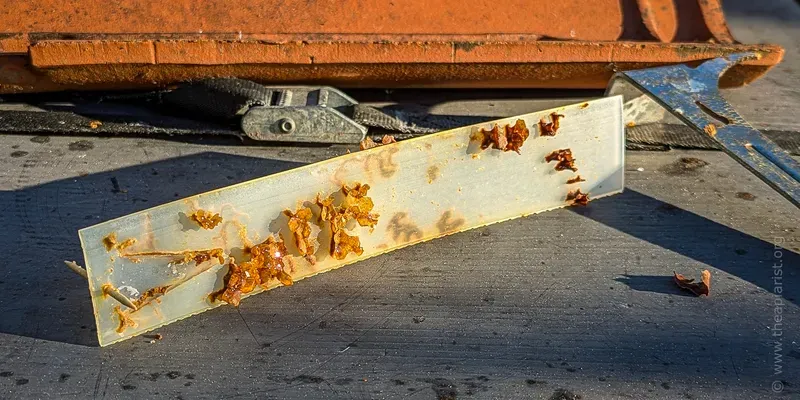
Winter bees
Whilst we know that the summer bee and winter bee population are completely different, both numerically, physiologically and in terms of their longevity, we don't know a lot about the precise timing of this changeover in the colony.
Partly this is because there are relatively few studies that have looked at this important event in the lifecycle of the honey bee, but largely it is because it is likely multifactorial, with many of these factors (things) interacting and/or difficult to modify experimentally.
Think about what's happening as the year transitions from summer to autumn; the day length (photoperiod) is reducing, the average temperature is dropping (and the maximum and minimum daily temperatures, which are distinct factors are also reducing {{8}}). In turn, these environmental changes result in a reduction of available nectar and pollen forage as the numbers of flowering plants and trees gets smaller.
I could go on ... but you get the general idea.
Having considered some of the factors, think about how you might individually change them to investigate whether it influences winter bee production.
For example, how could you reduce day length and still allow the bees to forage for nectar and pollen? And, if you think that's tricky, what about lowering the mean daily temperature faster to see if the onset of winter bee production is brought forward?
However, despite these technical difficulties, there are studies dating back to the 1970's that investigated a role for photoperiod and temperature in directly influencing winter bee production, and it is clear that neither completely account for the phenomenon.
But perhaps they indirectly influence something else that is responsible for the transition to winter bee production?
Pollen
It has long been known that reductions in day length and temperature are associated with reduced forage - nectar and pollen - availability in the environment.
Furthermore, several studies - and basic observation - have shown that the availability of pollen in particular has a profound effect upon brood rearing.
Short-term non-availability of pollen e.g. 3 days of rain, leads to cannibalism of young larvae and a reduced larval period before capping (Schmickl and Crailsheim, 2001), with longer periods of pollen dearth resulting in the complete cessation of brood rearing (Mattila and Otis, 2006).
So, if pollen becomes limiting in autumn, and this results in reduced levels of brood rearing, how could this influence the transition to winter bee production?
To understand this we need to go back to the mid-1950's when Maurizio (1954 {{9}}) demonstrated that queenless colonies in summer (i.e. with no brood to rear) produced long-lived bees that were physiologically similar to winter bees.
The rationale goes something like this ... if the queen is removed from a colony, any workers that emerge after her removal will have little or no further brood to rear. As a consequence, with no brood rearing to do, the young bees in the colony do not mature to middle aged bees and foragers, but instead remain as juvenile bees {{10}}.
And juvenile bees, produced in mid/late autumn, are the winter bees that will get the colony through until the following Spring.
So, is there any practical evidence that reduced pollen availability induces winter bee production?
It just so happens that there is 😉.
Mattila and Otis (2007)
Heather Mattila and Gard Otis investigated a role for pollen (or the lack thereof) in winter bee production. Experimental colonies were either depleted of pollen using pollen traps applied from late-August (a treatment regime known to reduce stored pollen by ~60-90%), or supplemented with pollen patties (2:1 w/w with sucrose, with each colony receiving ~1.3 kg of additional pollen during the study period), or untreated and used as controls.
Pollen depletion or supplementation lasted from late August to late October.
How do you measure winter bee production?
If you count and mark all the bees that emerge during a particular time window, and then look at their survival over subsequent days and weeks, you can plot a line graph with an inflection point {{11}} that clearly indicates the switch from high mortality (the short-lived summer bees) to low mortality (the long-lived winter bees).
If the addition or removal of pollen changes the position of this inflection point, it suggests that pollen availability is involved in the switch to winter bee production.
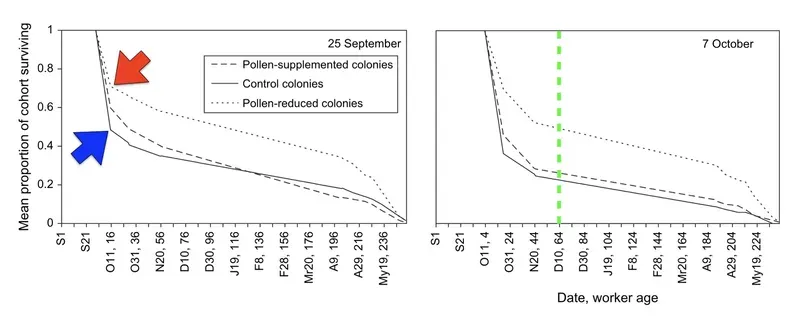
In the graphs above, and there are lots more in the paper, the colonies depleted of pollen (dotted lines) exhibit an obvious change in the inflection point, indicated with a red arrow, compared with the controls (solid line) and pollen-supplemented colonies (dashed line) marked with a blue arrow.
Consequently, a higher proportion bees survive at a later sampling date in the pollen-depleted colonies when compared with the pollen-supplemented or control colonies.
The bees are living longer.
For example, for bees that emerged on the 7th of October (right graph) and sampled on December 10th (D10; 64 days after the cohort were marked, indicated with the green dotted line), ~50% survived when pollen depleted, in comparison to ~25% survival of the control or pollen supplemented bees.
Still with me?
OK, that was heavy going 😓.
The results of the Mattila and Otis (2007) study are really striking and can be summarised as follows:
- the longevity of workers was inversely proportional to the level of brood remaining to be reared when the workers emerged
- the appearance of long-lived winter bees did not occur until brood rearing declined, which - in turn - was determined by the availability of pollen
- colonies supplemented with pollen in autumn reared brood for longer and delayed the production of winter bees
- irrespective of the timing of winter bee production (whether advanced by pollen depletion or delayed by pollen supplementation) the overall number of winter bees produced was the same.
This Mattila and Otis paper is probably one of the most significant studies of winter bee production.
If you want a more comprehensive overview of the topic, including other factors that may be important, I suggest you have a look at Christina Grozinger's review from a decade ago (Döke et al., 2015).
Too late matey!
I received an email from Thorne's a few days ago asking me if I was "thinking about your Autumn Varroa treatment" and encouraging me to purchase some Apivar.

My initial thought was that it was a month or so too late.
In my experience, effective Varroa control in the autumn means adding the miticide as soon after removal of the summer honey as possible. That way I can be certain that all the winter bees are reared in the presence of miticide, and consequently an ever-diminishing level of Varroa mites.
By preventing the winter bees from being exposed to Varroa (and the prematurely ageing effects of the deformed wing virus it transmits when feeding) I can expect to have lots of healthy winter bees to help my colonies survive to the following Spring.
And they usually do 😄.
However, having now re-read the Mattila and Otis study for this post, and given it a bit more thought, I should qualify my initial response ('Too late matey!') with a caveat about the availability of pollen in the environment.
If abundant pollen is available, and the weather is good enough for the bees to access it, then brood rearing will continue, and winter bee production will be delayed ... so perhaps it's not too late to treat.
If abundant pollen is available and the weather remains good.
Mattila and Otis penned additional studies on the impact of pollen availability on brood rearing. In doing the background reading for this post I also read these.
I've already written far too much this week, so will return to this subject - pollen and brood rearing - and the implications these studies have for practical beekeeping next time.
To be continued ...
Sponsor The Apiarist
The Apiarist covers 'the science, art and practice of sustainable beekeeping ... so much more than honey' and I write it to avoid the gardening and DIY chores.
If you found this post 'faintly amusing or vaguely informative', or that it helped or inspired your beekeeping, then please consider sponsoring The Apiarist.
Sponsorship costs less than £1/week annually, or currently little more than a large cappucino monthly. Sponsors help ensure the weekly posts appear, receive an irregular (approximately monthly) newsletter, and have access to an increasing number of sponsor-only content ... those starred ⭐ in the lists of posts.
Alternatively, you can help reduce my caffeine overdraft ... and please spread the word to encourage others to subscribe.
Thank you.
References
Döke, M.A., Frazier, M., and Grozinger, C.M. (2015) Overwintering honey bees: biology and management. Current Opinion in Insect Science 10: 185–193 https://www.sciencedirect.com/science/article/pii/S2214574515000930.
Mattila, H.R., and Otis, G.W. (2006) Influence of Pollen Diet in Spring on Development of Honey Bee (Hymenoptera: Apidae) Colonies. Journal of Economic Entomology 99: 604–613 https://doi.org/10.1093/jee/99.3.604.
Mattila, H.R., and Otis, G.W. (2007) Dwindling pollen resources trigger the transition to broodless populations of long-lived honeybees each autumn. Ecological Entomology 32: 496–505 https://onlinelibrary.wiley.com/doi/abs/10.1111/j.1365-2311.2007.00904.x.
Schmickl, T., and Crailsheim, K. (2001) Cannibalism and early capping: strategy of honeybee colonies in times of experimental pollen shortages. J Comp Physiol A 187: 541–547 https://doi.org/10.1007/s003590100226.
{{1}}: Don't bother, I've tried and failed.
{{2}}: Don't ask how I know this.
{{3}}: As it happens, almost certainly ... but not until the days have shortened yet further and I start planning things for the season ahead.
{{4}}: Apologies, it's easier to use a single term than have to repeatedly write something like 'functional or behavioural specialisation at specific ages'.
{{5}}: Having recently moved house this should more accurately be written as 'the part of Scotland that my bees inhabit' ... which is currently different from my part of Scotland.
{{6}}: Remember, this was late afternoon, so all the foragers were 'at home'.
{{7}}: No glasses, cool, early evening fading light, didn't have time, didn't need to, couldn't be bothered etc.
{{8}}: For example, you could have winter bee production independent of the average temperature, but entirely responsive to the reducing minimum daily temperatures.
{{9}}: Unfortunately, this reference is unavailable and the original is in German, but the results are described in Mattila and Otis, 2007.
{{10}}: Any parents reading this will appreciate how raising kids ages you 😉.
{{11}}: Essentially the kink in the line where the summer bees have died off and the winter bees remain.
Join the discussion ...